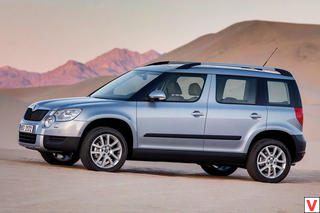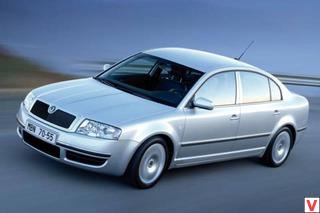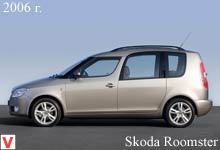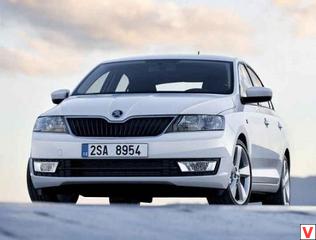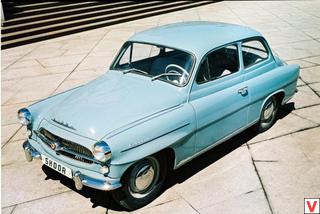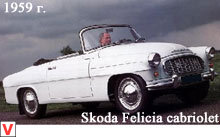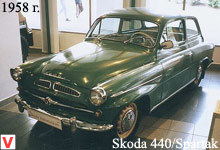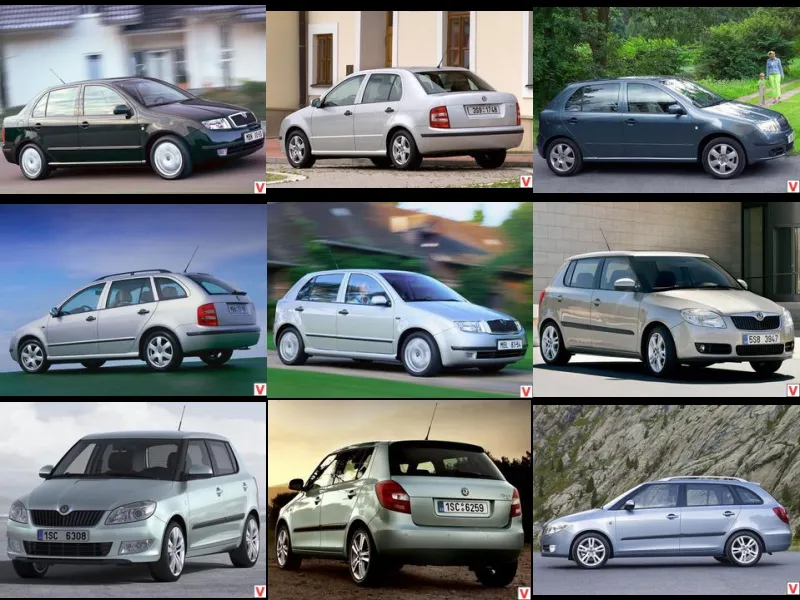
The compact model Fabia was introduced in late 1999. The car was built on the same platform as the Volkswagen Polo, equipped with a wide range of engines, which were developed not only by Skoda specialists, but also by Volkswagen engineers. At first, the Skoda Fabia had only a hechtbek body, but in 2000 it produced the Skoda Fabia Combi wagon, and since 2001, a 4-door sedan has been made in the Czech Republic. A year after the debut in the world, more than 600 thousand Skoda Fabia fled. Visually, this model looks very stylish and dynamic.
The contours of the body are associated with a respectable Octavia, rather than with a rustic Felicia. Belonging to the Skoda brand can be identified by the characteristic chrome-plated rectangular grille with a large emblem. At the same time, trapezoidal headlamps with smooth glass give the front of the Fabia a pleasant newness. It is noteworthy that the Skoda Fabia is the largest car among all its fellows, for example, the Czech model wins the Polo 65 mm. Due to the increased wheelbase, the interior of the Fabia is much more spacious than that of many classmates.
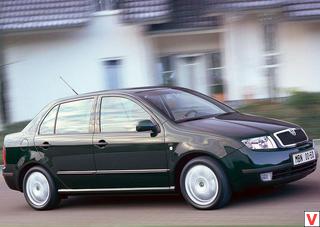
The ground clearance is 165 mm. The interior is very solid and strongly resembles many cars of the Volkswagen concern. Ergonomics salon at the highest level. For the storage of small things in Fabia are as many as two boxes on the center console, although in normal conditions one of them will definitely take the radio. To connect the radio, everything is ready, even in standard Fabia has four speakers and an antenna. Skoda Fabia first had three complete sets, which were designated as Classic, Comfort and Elegance. A little later two more simple and austere Basic and Junior appeared.
Cars in the last two versions are a bit cheaper than the rest, since they lack the power steering, a shelf above the trunk, and even the glove box lid. Although the Classic version is also not very rich, there is not even an electric front window regulator. But at your service is a heating and ventilation system with a filter, as well as an audible indicator telling you to turn on the head light. The Comfort version comes with fog lamps, side mirrors painted in body color, and side moldings.
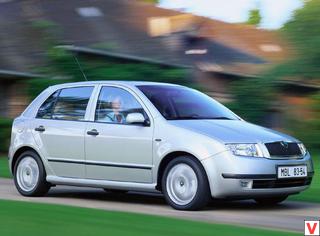
In addition, the driver's seat is adjustable in height, supplied on-board computer, front electric windows and central locking with an alarm system, which does not allow to open the door, even if the glass is broken. The most expensive version - Elegance, has a bright elegant interior with a large number of chrome lining, full power, climate control and electrically heated seats. For the storage of soft drinks in the cabin there are two small air-conditioned compartments. From a practical point of view, the wagon is the most profitable.
All 262 mm gains in length (4 222 mm in the station wagon versus 3 960 mm in the hatchback) are used to increase the trunk volume. In the five-seater version of the Skoda Fabia, its volume is 426 liters (260 liters for the hatchback), and if the rear seat is expanded, you can carry up to 1,225 liters of cargo. The weight of the Skoda Fabia at the same time increased slightly - only 36 kg, which does not greatly affect its dynamics and fuel consumption. Using the Skoda Fabia trunk is very convenient, it even provides loops for securing cargo, but the net itself is not included in the Classic package.
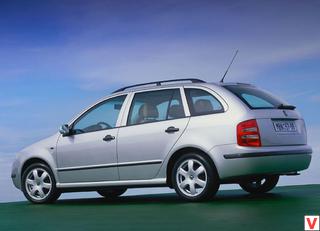
A full-size "spare tire" was located under the boot floor, and next to it was a volumetric box, molded for various small things. Skoda Fabia buyers have a large selection of power units (a total of 12 of them). Four engines of 1.4 liters. Two of them with 60 hp and 68 hp are slightly upgraded 8-valve units, installed on the old Skoda Favorit of the 80s, and later on the Felicia. Two other engines with 75 hp or 101 hp already have a 16-valve system and they are developed by Volkswagen.
This is followed by more modest units with a volume of 1.0 l. (50 hp) and 1.2 liters. (54 hp or 64 hp depending on the version). The powerful 2.0-liter unit of 116 hp power closes the line of petrol engines. Two options of diesel engines of the same volume, but of different power, complete the picture. The basic version is equipped with a 1.9-liter 64-strong atmospheric unit with direct fuel injection and four valves per cylinder.
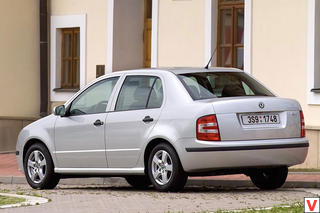
A more powerful version, also a 1.9-liter, has a turbocharger with electronic adjustment of the geometry of the turbine and pump injectors and develops a power of 101 hp. Plus a 1.4 liter diesel engine. (75 hp). A few words about the fastest Skoda Fabia, which has the prefix RS. This “charged” hatchback has a 1.9 liter diesel engine with a power of 130 hp under the hood. This power unit allows the car to accelerate over 200 km / h. Do not forget the experts Skoda and safety Fabia. In the 2000 model, the standard equipment includes an inflatable airbag for the driver, front belts with pretensioners and tension force limiters.
Front airbags for the passenger and belts are offered for an extra charge. It is possible to install an automatic transmission, ABS and APS. At the auto show in Paris in 2004, Skoda introduced the updated Fabia. True, all the changes that have befallen the car in the sixth year of production are very insignificant and unobtrusive. The main stylistic innovations touched the appearance of the Fabia, which now combines the features of the “family” Octavia and a sports car: a new bumper with a narrow rectangular grille in the middle instead of the former horizontal stamping, new rims. Appeared "fog" of the original form, offered only by order or in expensive trim levels.
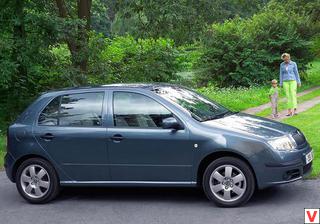
And in the back is new optics of the same form, but with horizontal “slots” of colorless reversing lights in the style of the Octavia II model. Inside, too, there was a reminder of the second-generation Octavia - this is a new four-spoke steering wheel. By the way, at Fabia even the simplest versions have a steering column adjustable in two directions. Modification 2005 produced in three body styles - hatchback, sedan and wagon. The panel and center console have changed little.
In particular, the upper part of the panel, which is located near the windshield, made "porous." In addition, on the base version, instead of a two-tone black and gray finish, the entire panel is now made of black monochrome plastic. There are new colors and options for seat trim and interior. Fabia fully meets the safety standards that came into force in 2005. The basis of passive safety is an extremely durable and torsion-resistant body with crushable areas in front and behind. In the door mounted amplifiers for protection against side impact. Also reinforced central pillars. And the rest of the Fabia remained the same with its advantages and disadvantages.
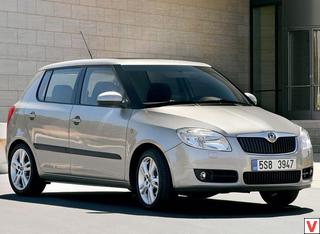
Good noise isolation, harsh but energy-intensive suspension, well-working gearbox - all this is already familiar to the happy owner of Skoda. The second generation of the Fabia hatchback (internal code type 5J) was presented at the Geneva Motor Show in March 2007. Six months later, a wagon was introduced in Frankfurt. It still uses the PQ24 platform, but is slightly larger in size. The car has changed both externally and internally. Designers and engineers have worked on bumpers, optics and wings. The pronounced horizontal line outwardly makes the car a little lower, although the height of the car has not changed. Fabia II has grown significantly, adding 22 mm in length.
The increase in length is reflected in the size of the cabin. In addition, the driver and passenger sit 3 cm higher than the first Fabia. Rear, of course, not so spacious, but by the standards of class B, comfort is decent.
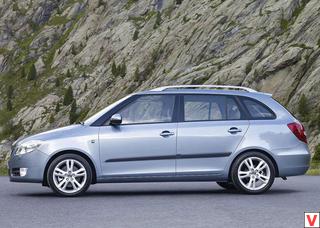
The volume of the trunk of the Skoda Fabia increased to a significant 300 liters (+40 to the previous model), although the rear overhang added only 18 mm. The interior of the Fabia II can be described as follows: modest and tasteful. There are no breathtaking stylistic solutions in it. If desired, the internal space can be revived by bright upholstery of the seats or by ordering a car with a two-tone (gray-black or beige-black) trim. Ergonomics cabin at altitude. All buttons and levers are clear and logical.
The seats, especially in the Sport version, perfectly fix the body. Breathable seat upholstery and improved climate control add comfort. The steering wheel is configured in two planes. The range of engines is represented by four petrol engines ranging from 1.2 to 1.6 liters and three diesel engines of 1.4-1.9 liters. The engines are paired with a 5-speed manual transmission or with a 6-speed Tiptronic automatic, which allows you to manually select the gear.
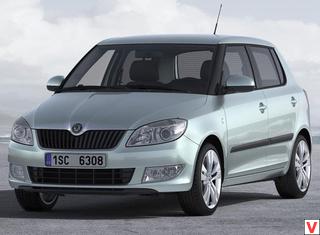
The base model with a 1.2 liter engine is 5 kg lighter than its predecessor. And the load capacity of the Skoda Fabia is simply amazing - it is ready to carry 515 kg. Many changes in the security system Skoda Fabia. The car received adaptive headlights. Instead of the internal reflective surface, the headlamps use a lens to diffuse, similarly to xenon.
Depending on the angle of rotation of the steering wheel, the lamp turns inside the headlamp up to 15 degrees to the outside and up to 7.5 degrees to the inside of the turn. In the event of an accident, the emergency lights turn on independently, as well as the interior light, the central locking is unlocked, the fuel pump is turned off, and the gas supply from the fuel tank is turned off. In the basic configuration Skoda Fabia is equipped with only the driver's airbag and belt pretensioners. If desired, the car can be equipped with curtain airbags.
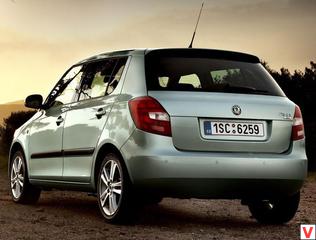
During the collision, they create an inflatable barrier along the side of the car, which protects the passengers from serious injuries to the head and shoulders. Equipped with 6 airbags, the Fabia has earned 4 stars out of 5 in the crash tests of the EuroNCAP program (32 points). The traumatic front panel and the rear door lock that opened during a side impact prevented me from typing more. Protection of passengers-children worked well - 3 stars (36 points) out of 5. Pedestrian safety was rated at 2 stars (17 points) out of 4 possible.
The Skoda Fabia lineup, consisting of a hatchback and a station wagon, underwent a small facelift in 2010. The car has noticeably increased in size, which now amounted to 4000x1642x1498 mm (in the hatchback). Designers gave the Fabia look more dynamics: the horizontal line of the bumper with a new grille, dark "lacquered" front and side racks, as well as a new form of the main and fog lamps visually expanded the front of the car. Slanted headlights with "pupils" -leeples, embossed hood with a massive chrome strip. Sharp corners in the side window lines give the car a more confident look.
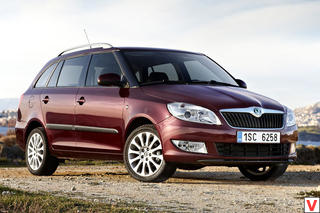
In addition, Fabia received new alloy wheels and three new colors (light blue Aqua Blue, deep blue Pacific Blue and green metallic Racing Green). Freshness in appearance definitely appeared, but the line between the old and the new design was very thin. The main result was achieved: Fabia looked younger.
The changes in the interior are also not very significant: the blue instrument lighting instead of the green one, another on-board computer display, which now displays a hint about the need to change to another gear, as well as the new Amundsen head unit with integrated navigation and a 5-inch touchscreen. Climate control is located at the top of the center console, thanks to the simplicity and consistency of the keys, even a novice driver can understand it. Audio controls moved from the steering column switch to the left spoke.
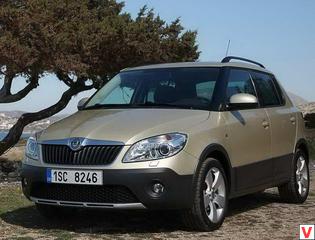
The Fabia has a new steering wheel - the same as the Octavia and Superb. It is also worth noting the number of useful compartments for small things. They are located in the front panel, doors, under the front seats and in their backs, the center console and even in the trunk. And here's another thing: now you can order rails for the hatchback - such as those that are installed on the roof of the station wagon. By the way, Skoda representatives call the updated Fabia one of the most spacious in its class. For example, with the rear seats folded, the volume of the luggage compartment at the hatchback is 1163 liters.
For Fabia, the manufacturer offers three diesel units: 1.2 l TDI with 75 hp, new 1.6 l TDI with 90 hp and 105 hp All three engines - with injection with a common injection pipe and particulate filter. The advantage of these TSI and TDI engines is that they reduce fuel consumption and lower CO2 emissions. All units comply with Euro-5 standards. So, fuel consumption 1,2 TSI 105 hp in combination with the seven-speed DSG is 5.3 l / 100 km, and the emission level is 123 g / km, which is 56 g less than the model it replaced (1.6 liter, 105 hp with Tiptronic automatic transmission). Significantly increased the safety of Fabia.
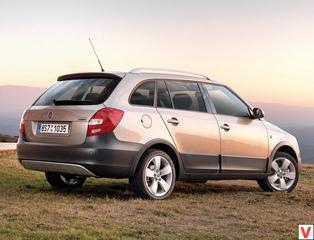
So, depending on the configuration, the car is equipped not only with airbags for the driver and passenger in the front seat, but also for those who sit in the back. A child seat with an ISOFIX attachment system can be installed in the back seat. Traditionally, the choice of the buyer offers four options: the basic Classic, Ambiente, Sport and Elegance. In the basic configuration there is already an immobilizer, ABS and EBC (emergency braking assistance), headlight adjustment, on-board computer and heated mirrors.
Rear-view mirrors in all trim levels, except the most expensive, - with mechanical adjustment. But for any performance bumpers painted in body color. Trying to expand the range of its Czech division, the Volkswagen Group offers pseudo-off-road versions of the Skoda Scout, this trend did not pass by the youngest model in the line. So there was a Fabia Scout. The example was taken from cross-versions of Volkswagen cars. However, in German cars behind the off-road attachment, there is not only a change in appearance, but also increased ground clearance, all-wheel drive and other technical differences from civilian modifications.
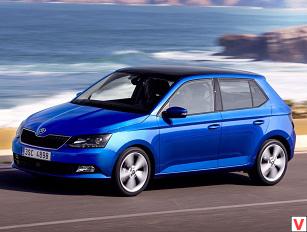
Skoda made it easier, and therefore the Fabia Scout is more a tuning exterior package than a serious attempt to upgrade a small hatchback. In this case, all changes were reduced to increased ground clearance (149 mm in Scout instead of 134 mm in the standard) and "off-road" appearance. The Scout option gives the small car a more brutal look, thanks to unpainted plastic lining on the bumper, wings and sills, a silver imitation of the crankcase protection, black roof rails and 16-inch Arktos alloy wheels. The front bumper is complemented by round fog lights and an original silver-colored protective plate.
A large silver-colored plastic diffuser is attached to the bottom of the rear bumper. Complements the appearance of toning SunSet. In the interior of the standard version of the Fabia Scout distinguished sports seats, instrument cluster with a special design, metal lining on the pedals and floor mats with the logo of the model.
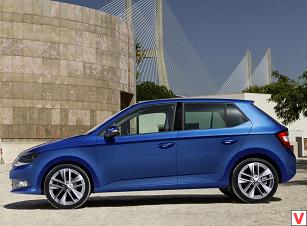
The gear knob and frame, vent vents and parking brake button are decorated with matte silver finish. The leather multifunctional three-spoke steering wheel and center console with a Maxi Dot display provide the driver with maximum comfort, and for the comfort of the passengers there is a radio and Climatronic climate control system. To this should be added a cooled glove box, additional boxes for storing small items under the front seats and in the luggage compartment, as well as comfortable light bulbs for rear passengers and hooks for securing cargo in the trunk. In short, everything you need is present, and the rest can be ordered for an additional fee.
However, this entire package of options is also available to owners of the civilian version of the Skoda Fabia, under the names Dynamic and Functional. The strength of this model is the ease of interior transformation. The trunk of a hatchback, of course, is not at all big. But easily removed light rear seat cushions allow you to fold their backs so that the increased luggage compartment is a flat floor. The range of power units Skoda Fabia Scout is quite extensive, four petrol engines and three diesel units are available.
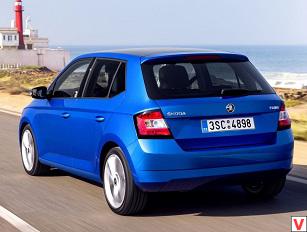
However, a single, but the most powerful gasoline engine with a displacement of 1.2 liters and 105 hp will be available for the Russian consumer. It is aggregated by a five-speed manual gearbox or a seven-band DSG robotic gearbox with two clutches, which has a sports and manual modes. Moreover, the combination of this engine and DSG transmission is available only to owners of Skoda Fabia Scout. Independent suspension is comfortable enough, the steering is equipped with an amplifier, and all wheels are disc brakes. The world premiere of the 3rd generation Skoda Fabia was held at the Paris Motor Show in early October 2014.
The Czech company presented the car in two body styles at once: a five-door hatchback and a station wagon. This generation was assigned the factory index PQ26. It is noteworthy that the Fabia is the second most important car in the Skoda lineup after the Octavia model. At the end of 2013, more than 200 thousand copies of various versions and modifications of the previous generation Skoda Fabia were sold in the world. And since the debut of the model in 1999, the total circulation amounted to more than 3.5 million cars, with the station wagon sales exceeding the bar of 1.1 million.
The third generation was based on a modernized and slightly elongated platform from the predecessor Fabia 2 generation. From the new Volkswagen platform MQB updated Fabia got new engines, electrics, electronics, electric power steering and XDS + electronically controlled cross-axle locking. Compared with the previous generation, the hatchback length was reduced by 8 mm (to 3992), the width increased by 90 mm (to 1732), and the height decreased by 30 millimeters (to 1468). The wheelbase added 5 mm and is now equal to 2470 mm. Front wheel track - 1463 mm, rear wheel track - 1457 mm, ground clearance - 135 mm.
The transition to a new generation has allowed to slightly reduce the weight of the car, so now the curb weight Skoda Fabia in the basic configuration will be 980 kg instead of the previous 1020 kg. The exterior of the car has changed quite noticeably, but on the whole the design has remained recognizable. In the design of the exterior there are more sharp edges, and a number of elements, such as the grille and lighting engineering, are made in the style of the Radid and Octavia 3 models.
The company itself claims that the exterior of the Fabia 3 is made in the style of the Vision C concept, first shown on the motor show in Geneva 2014. In the contours of the body has become more dynamic, the car matured and began to look much more solid and more exciting than its predecessor. The front part of the body is characterized by new large headlights with lenses of low-beam optics, stylishly underlined strokes of daytime LED running lights, a compact bumper with a large air intake and a solid-sized fog. The design of the stern is emphasized strictly: compact bumper, neat ceiling lights, comfortable tailgate with a large glass topped with a spoiler.
And if the hatchback looks fit and sporty, then the wagon is solid and respectable. The manufacturer offers 15 colors of enamel for painting the body, two types of caps for steel rims and six design options for alloy wheels, but that's not all. As an option, it is possible to order the coloring of the roof, front pillars, wheel spoilers, and rear-view mirror cases in contrasting colors from the main body color (white, silver, black, and red), resulting in 125 combinations.
Salon Fabia 3 retained the same conservatism, harsh finishing materials, but added in terms of ergonomics: landing on both rows of seats became noticeably more comfortable, visibility from the driver's seat slightly improved, the revised center console is more convenient to use, and the gearshift knob has moved a little closer to the driver . Plus, the interior got a lot of niches for storage, and equipment includes a MirrorLink function, a panoramic roof, several options for finishing the seats and three options for a multimedia system.
The volume of the trunk of the Skoda Fabia III hatchback is 330 liters (+ 15), and when the backrest of the rear sofa is folded, the compartment increases to 1,150 liters. The size of the luggage compartment at the station wagon Fabia Combi reaches 530 liters with the possibility of increasing to 1395 liters. As for the power units, four gasoline and three diesel engines are provided for the Fabia 2015, but not all of the engines presented will be on the Russian market. The base is a new 1.0-liter three-cylinder engine with 60 hp. In a more productive modification, the same engine develops 75 hp already.
Just above the turbocharged 1.2-liter gasoline unit TSI, which, depending on the degree of boost, develops 90 hp. (160 Nm) or 110 hp (175 Nm) power. The list of diesel power plants is represented by three modifications of the 3-cylinder 1.4-liter TDI turbo unit, which develops 75, 90 or 105 hp. power. Engines, as before, work either with 5-and 6-speed mechanics, or with 7-band “robot” DSG. The 1.2-liter gasoline engine consumes an average of 6.0 - 6.1 liters of gasoline, depending on the degree of boost, and the 105-horsepower diesel engine does fit into 3.5 liters per 100 km.
The front end of the body is based on an independent suspension with MacPherson struts, and the rear is supported by a semi-dependent suspension based on a torsion beam. The wheels of the front axle are supplied with ventilated disc brakes, classic drum brakes are used on the rear wheels. Rack and pinion steering hatchback supplemented electro-hydraulic amplifier. The third generation Fabia has a richer equipment list. The car can be equipped with adaptive cruise control, stability control, driver fatigue control, automatic parking, climate control, a new system of keeping cars in the desired lane and even a panoramic roof.
Cars for the Russian market (except for the Scout version) are produced in Kaluga.
